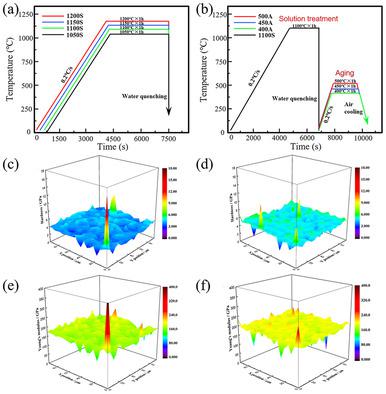当前位置:
X-MOL 学术
›
Steel Res. Int.
›
论文详情
Our official English website, www.x-mol.net, welcomes your
feedback! (Note: you will need to create a separate account there.)
Effect of Aging Treatment on Precipitates and Intrinsic Mechanical Behavior of Austenitic Matrix in Ti–V–Nb-Alloyed High-Manganese Steel
Steel Research International ( IF 1.9 ) Pub Date : 2021-04-14 , DOI: 10.1002/srin.202000650 Quan Shan 1, 2 , Tianyi Zhang 1, 2 , Zulai Li 1, 2 , Zaifeng Zhou 1, 2 , Yehua Jiang 1, 2 , Yun-Soo Lee 3, 4 , Xu Luo 5
Steel Research International ( IF 1.9 ) Pub Date : 2021-04-14 , DOI: 10.1002/srin.202000650 Quan Shan 1, 2 , Tianyi Zhang 1, 2 , Zulai Li 1, 2 , Zaifeng Zhou 1, 2 , Yehua Jiang 1, 2 , Yun-Soo Lee 3, 4 , Xu Luo 5
Affiliation

|
The collaboration of precipitated particles and austenitic matrix plays a significant role in the overall wear performance of high-manganese (high-Mn) austenitic steels. The austenitic matrix cannot support micrometer-sized precipitates because of its poor Young's modulus and hardness before work hardening, and the relative sliding of abrasive particles over the matrix may result in the precipitates detaching from the matrix and deteriorating the overall wear performance of the steels. Herein, a solid-solution temperature of 1100 °C is applied to balance the size of the austenite grains and precipitates. Different volume fractions of submicrometer V2C are precipitated in the austenitic matrix by aging at different temperatures, and the volume fraction of submicrometer V2C precipitates increases with aging treatment temperature. When the aging temperatures are higher than 450 °C, Young's modulus and nanohardness of the austenitic matrix are significantly enhanced, and the overall Brinell hardness and strength of the specimens are also improved. The improvement in the mechanical properties of the matrix is mostly related to the precipitation strengthening of nanoscale precipitates, and the enhancement in the overall hardness of the steels is mainly related to a sufficient amount of precipitated submicrometer V2C particles in the austenitic matrix.
中文翻译:

时效处理对 Ti-V-Nb 合金高锰钢中奥氏体基体析出物和固有力学行为的影响
沉淀颗粒和奥氏体基体的协同作用对高锰(高锰)奥氏体钢的整体磨损性能起着重要作用。奥氏体基体由于其加工硬化前的杨氏模量和硬度较差,不能承载微米级析出物,磨粒在基体上的相对滑动可能导致析出物从基体上脱离,降低钢的整体磨损性能。在此,采用 1100 °C 的固溶温度来平衡奥氏体晶粒和析出物的尺寸。亚微米的V不同体积分数2 C被在奥氏体基体通过在不同温度下老化沉淀,亚微米V的体积分数2C析出物随时效处理温度增加。当时效温度高于450℃时,奥氏体基体的杨氏模量和纳米硬度显着提高,试样的整体布氏硬度和强度也得到提高。基体力学性能的提高主要与纳米级析出物的析出强化有关,钢整体硬度的提高主要与奥氏体基体中析出足够量的亚微米V 2 C颗粒有关。
更新日期:2021-04-14
中文翻译:

时效处理对 Ti-V-Nb 合金高锰钢中奥氏体基体析出物和固有力学行为的影响
沉淀颗粒和奥氏体基体的协同作用对高锰(高锰)奥氏体钢的整体磨损性能起着重要作用。奥氏体基体由于其加工硬化前的杨氏模量和硬度较差,不能承载微米级析出物,磨粒在基体上的相对滑动可能导致析出物从基体上脱离,降低钢的整体磨损性能。在此,采用 1100 °C 的固溶温度来平衡奥氏体晶粒和析出物的尺寸。亚微米的V不同体积分数2 C被在奥氏体基体通过在不同温度下老化沉淀,亚微米V的体积分数2C析出物随时效处理温度增加。当时效温度高于450℃时,奥氏体基体的杨氏模量和纳米硬度显着提高,试样的整体布氏硬度和强度也得到提高。基体力学性能的提高主要与纳米级析出物的析出强化有关,钢整体硬度的提高主要与奥氏体基体中析出足够量的亚微米V 2 C颗粒有关。











































 京公网安备 11010802027423号
京公网安备 11010802027423号